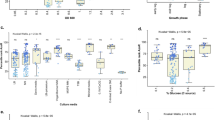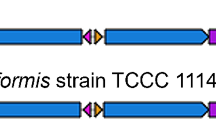Abstract
Molecular studies of copper and cadmium resistances in acidophilic bacteria are significant in biomining. In this study, afe_1862, which encodes a heavy metal-binding protein in Acidithiobacillus ferrooxidans L1, was amplified using PCR, cloned into the pET32a plasmid, and sequenced. Following SDS-PAGE analysis, optimization of the expression conditions and heterologous overexpression of afe_1862 in Escherichia coli BL21 in the presence of Cu2+ and Cd2+ were studied as well. The results indicated that AFE_1862 has higher resistance to Cu2+ than Cd2+. Bioinformatics analysis illustrated that AFE_1862 has a conserved HMA domain containing heavy metal-binding sites, which may play a role in transporting or detoxifying heavy metals.







Similar content being viewed by others
References
Xu L, Song Q, Mao C (2004) Metal-binding proteins or peptides in the bioremediation of environmental heavy metals. Prog Biotechnol 24:39–43 (in Chinese)
Mao C, Xue Y, Wang H (2001) Progress of microbial display technology in the bioremediation of heavy metals. Prog Biotechnol 21:49–51 (in Chinese)
Castagnetto JM, Hennessy SW, Roberts VA, Getzoff ED, Tainer JA, Pique ME (2002) MDB: the Metalloprotein Database and Browser at The Scripps Research Institute. Nucleic Acids Res 30:379–382
Dhal NK, Pattanayak B, Padhi S (2014) Genetic engineering to express metal binding proteins and peptides: implications for bioremediation. Biolife 2:442–451
Mejáre M, Bülow L (2001) Metal-binding proteins and peptides in bioremediation and phytoremediation of heavy metals. Trends Biotechnol 19:67–73
Mejàre M, Ljung S, Bülow L (1998) Selection of cadmium specific hexapeptides and their expression as OmpA fusion proteins in Escherichia coli. Protein Eng 11:489–494
Harvey PI, Crundwell FK (1996) The effect of As (III) on the growth of Thiobacillus ferrooxidans in an electrolytic cell under controlled redox potentials. Miner Eng 9:1059–1068
Zhang Y, Wu X, Liu D, Duan H, Fan H (2013) Sequencing and bioinformatics analysis of the metal-related genes in Acidithiobacillus ferrooxidans strain DC. Folia Microbiol 58:551–560
Chan J, Huang Z, Merrifield ME, Salgado MT, Stillman MJ (2002) Studies of metal binding reactions in metallothioneins by spectroscopic, molecular biology, and molecular modeling techniques. Coord Chem Rev 233–234:319–339
Liu T, Nakashima S, Hirose K, Uemura Y, Shibasaka M, Katsuhara M, Kasamo K (2003) A metallothionein and CPx-ATPase handle heavy-metal tolerance in the filamentous Cyanobacterium oscillatoria brevis 1. FEBS Lett 542:159–163
Chaturvedi AK, Mishra A, Tiwari V, Jha B (2012) Cloning and transcript analysis of type 2 metallothionein gene (SbMT-2) from extreme halophyte Salicornia brachiata and its heterologous expression in E. coli. Gene 499:280–287
Navarro CA, Bernath DV, Bussenius CM, Castillo RA, Jerez CA (2016) Cytoplasmic CopZ-like protein and periplasmic rusticyanin and AcoP proteins as possible copper resistance determinants in Acidithiobacillus ferrooxidans ATCC23270. Appl Environ Microbiol 82:1015–1022
Xueling W, Yuan P, Qi H, Hou D, Miao B, Qiu G (2011) Bioleaching of chalcopyrite by Acidithiobacillus ferrooxidans DY15, DY26 and DC and difference expressions of gene Afe0022. Trans Nonferrous Metals Soc China 21:932–938
Kumar MS, Kaur G, Sandhu AK (2014) Genomic DNA isolation from fungi, algae, plant, bacteria and human blood using CTAB. IJSR 3:617–617
Gasteiger E, Hoogland C, Gattiker A, Duvaud SE, Wilkins MR, Appel RD, Bairoch A (1999) Protein identification and analysis tools on the ExPASy server. Methods Mol Biol 112:531–532
Petersen TN, Brunak S, Von HG, Nielsen H (2011) SIGNALP 4.0: discriminating signal peptides from transmembrane regions. Nat Methods 8:785–786
Andreozzi S, Chakrabarti A, Soh KC, Burgard A, Yang TH, van Dien S, Miskovic L, Hatzimanikatis V (2016) Identification of metabolic engineering targets for the enhancement of 1,4-butanediol production in recombinant E. coli using large-scale kinetic models. Metab Eng 35:148–159
Geourjon C, Deléage G (1995) SOPMA: significant improvements in protein secondary structure prediction by consensus prediction from multiple alignments. Comput Appl Biosci 11:681–684
Nakai K, Horton P (1999) PSORT: a program for detecting sorting signals in proteins and predicting their subcellular localization. Trends Biochem Sci 24:34–36
Gupta R, Brunak S (2002) Prediction of glycosylation across the human proteome and the correlation to protein function. Pac Symp Biocomput 7:310–322
Jensen LJ et al (2002) Prediction of human protein function from post-translational modifications and localization features. J Mol Biol 319:1257–1265
Szklarczyk D, Franceschini A, Wyder S, Forslund K, Heller D, Huerta-Cepas J, Simonovic M, Roth A, Santos A, Tsafou KP, Kuhn M, Bork P, Jensen LJ, von Mering C (2015) STRING v10: protein-protein interaction networks, integrated over the tree of life. Nucleic Acids Res 43:D447–D452
Azam M, Jan AT, Kumar A, Siddiqui K, Mondal AH, Haq QMR (2018) Study of pandrug and heavy metal resistance among E. coli from anthropogenically influenced Delhi stretch of river Yamuna. Braz J Microbiol 49:471-480
Kyte J, Doolittle RF (1982) A simple method for displaying the hydropathic character of a protein. J Mol Biol 157:105–132
Chen GQ, Meng P, Liu LL, Chen G, Wang P (2011) In silico cloning and characterization of Sorghum APX gene. J Bioinformatics 16:557–562 (in Chinese)
Lin YZ, Guo H, Huang SW, Liu CX, Liu TY, Chen XY (2010) In silico cloning and bioinformatics analysis of DREB1 gene from Pinus teada. J Bioinformatics 8:43–46 (in Chinese)
Lamb AL, Torres AS, O'Halloran TV, Rosenzweig AC (2001) Heterodimeric structure of superoxide dismutase in complex with its metallochaperone. Nat Struct Biol 8:751–755
Wernimont AK, Huffman DL, Lamb AL, O'Halloran TV, Rosenzweig AC (2000) Structural basis for copper transfer by the metallochaperone for the Menkes/Wilson disease proteins. Nat Struct Biol 7:766–771
Wu X, Zhang Z, Liu L, Deng F, Liu X, Qiu G (2014) Metal resistance-related genes are differently expressed in response to copper and zinc ion in six Acidithiobacillus ferrooxidans strains. Curr Microbiol 69:775–784
Mattie MD, Freedman JH (2004) Copper-inducible transcription: regulation by metal- and oxidative stress-responsive pathways. Am J Physiol Cell Physiol 286:C293–C301
Hartwig A, Asmuss M, Ehleben I, Herzer U, Kostelac D, Pelzer A, Schwerdtle T, Bürkle A (2002) Interference by toxic metal ions with DNA repair processes and cell cycle control: molecular mechanisms. Environ Health Perspect 110:797–799
Acknowledgments
The authors would like to give thanks to the participants, coordinators, and administrators for their supports during the study. This work was supported by Chinese National Natural Science Foundation (No. 31460032, 31760028 and 81660581).
Author information
Authors and Affiliations
Corresponding authors
Ethics declarations
Conflict of Interest
All authors declare that they have no conflicts of interest.
Electronic Supplementary Material
ESM 1
(DOCX 2620 kb)
Rights and permissions
About this article
Cite this article
Leng, F., Li, Y., Luo, W. et al. Cloning, Expression, and Bioinformatics Analysis of Heavy Metal Resistance Gene afe_1862 from Acidithiobacillus ferrooxidans L1 in Escherichia coli. Biol Trace Elem Res 189, 291–300 (2019). https://doi.org/10.1007/s12011-018-1462-3
Received:
Accepted:
Published:
Issue Date:
DOI: https://doi.org/10.1007/s12011-018-1462-3




